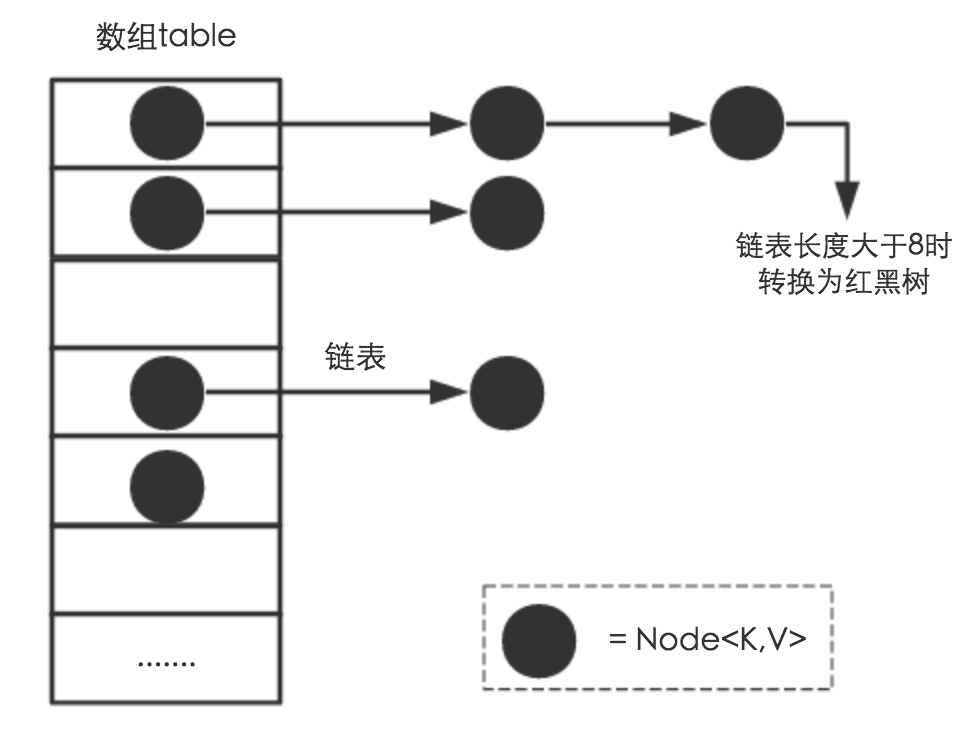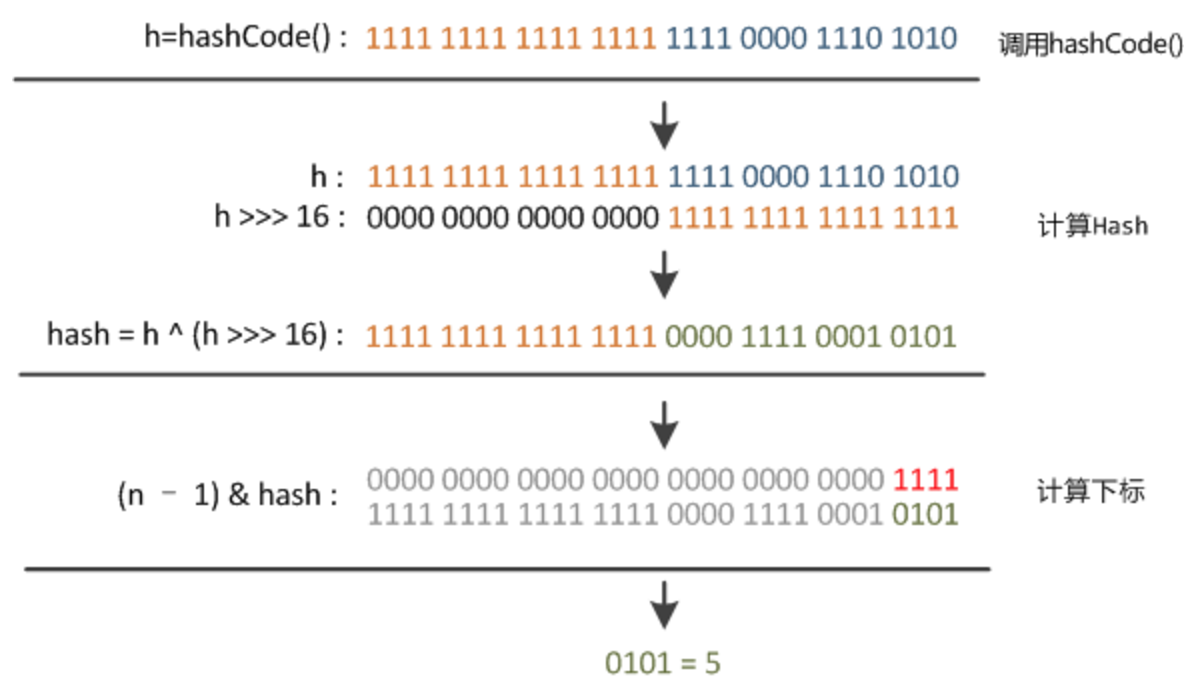回顾
之前写过一篇关于HashMap的文章 ,里面介绍了关于HashMap的基本概念,和简单的数据结构,但是并没有对HashMap的源码进行系统的分析。
HashMap主要结构是一个数组,数组的下标是hash值取余之后数,存储key和value的信息。允许key和value是null。HashMap的数组的使用率小于0.75(默认的0.75,也可以设置)。一般默认情况下数组的大小是16,随着数据的添加当HashMap的容量达到threshold(16*0.75=12)时候会扩容(resize),扩容是将原来的数组扩大两倍(HashMap的数组大小一定是2的n次方)。同时HashMap也不是线程安全的,在并发情况下resize可能会出现死锁。
HashMap除了数组之外还有一个是链表,链表是解决解决HashMap的中hashcode取模以后的碰撞问题,正常的hashcode的范围很大,碰撞的几率很小但数组没有那么大的空间,对内存占用太大;要在为hashcode取模,由于取余会导致hashcode碰撞,为避免之前数组的数据被覆盖。HashMap在数组后面添加了列表,来解决这个问题。在JDK8以后当链表长度超过8以后就会被替换成一个红黑树,这样可以提高查找和插入效率。
HashMap是如何设计的 HashMap是实现了Map接口、允许null键/值、非同步、不保证有序(比如插入的顺序)、也不保证序不随时间变化。在HashMap中有两个很重要的参数,容量(Capacity)和负载因子(Load factor)。Capacity就是buckets的数目,loadFactor就是哈希桶(就是数组)填满程度的最大比例。如果对迭代性能要求很高的话不要把Capacity设置过大,也不要把loadFactor设置过小。当哈希桶填充的数目(即HashMap中元素的个数)大于Capacity*loadFactor时就需要调整哈希桶的数目为当前的2倍也就是扩容,可能和上面的有些重复。
计算Hash值,根据Hash值计算哈希桶中数组的位置。由于HashMap使用数组+链表的方式实现,所以能否快速计算Hash值和根据Hash值找到元素的位置很重要。下面就是Hash值是如何计算的
1 2 3 4 5 6 7 8 9 10 11 static final int hash (Object key) int h; return (key == null ) ? 0 : (h = key.hashCode()) ^ (h >>> 16 ); } static int indexFor (int h, int length) return h & (length-1 ); }
这里的Hash算法本质上就是三步:取key的hashCode值、高位运算、取模运算。
对于任意给定的对象,只要它的hashCode()返回值相同,那么程序调用方法一所计算得到的Hash码值总是相同的。我们首先想到的就是把hash值对数组长度取模运算,这样一来,元素的分布相对来说是比较均匀的。但是,模运算的消耗还是比较大的,在HashMap中是这样做的:调用方法二来计算该对象应该保存在table数组的哪个索引处。
这个方法非常巧妙,它通过h & (table.length -1)来得到该对象的保存位(数组的下标),而HashMap底层数组的长度总是2的n次方,这是HashMap在速度上的优化。当length总是2的n次方时,h& (length-1)运算等价于对length取模,也就是h%length,但是&比%具有更高的效率 。但是hash值也就与数组的大小相关,所以每次resize的时候要重新进行Hash。所以链表和树都会被改变,resize是一个不小的开销(for循环套do-while循环),而且多线程下会出现并发问题。
在JDK1.8的实现中,优化了高位运算的算法,通过hashCode()的高16位异或低16位 实现的:(h = k.hashCode()) ^ (h >>> 16),主要是从速度、功效、质量来考虑的,这么做可以在数组table的length比较小的时候,也能保证考虑到高低Bit都参与到Hash的计算中,同时不会有太大的开销。
HashMap是如何实现的 首先看一下HashMap中的变量和他们的用途。
1 2 3 4 5 6 7 8 9 10 11 12 13 14 15 16 17 18 19 20 21 22 23 24 25 26 27 28 29 30 31 32 33 34 35 static final int DEFAULT_INITIAL_CAPACITY = 1 << 4 ; static final int MAXIMUM_CAPACITY = 1 << 30 ; static final float DEFAULT_LOAD_FACTOR = 0.75f ; static final int TREEIFY_THRESHOLD = 8 ; static final int UNTREEIFY_THRESHOLD = 6 ; static final int MIN_TREEIFY_CAPACITY = 64 ; transient Node<K,V>[] table; transient Set<Map.Entry<K,V>> entrySet; transient int size; transient int modCount; int threshold;
HashMap的基本构造函数,根据HashMap的参数来构造hashMap。
1 2 3 4 5 6 7 8 9 10 11 12 13 14 15 16 17 18 19 20 21 22 23 24 25 26 27 28 29 30 31 32 33 34 35 36 37 38 39 40 41 42 43 44 45 46 47 48 49 50 51 52 53 54 55 56 57 58 59 60 61 62 63 64 public HashMap (int initialCapacity, float loadFactor) if (initialCapacity < 0 ) throw new IllegalArgumentException("Illegal initial capacity: " + initialCapacity); if (initialCapacity > MAXIMUM_CAPACITY) initialCapacity = MAXIMUM_CAPACITY; if (loadFactor <= 0 || Float.isNaN(loadFactor)) throw new IllegalArgumentException("Illegal load factor: " + loadFactor); this .loadFactor = loadFactor; this .threshold = tableSizeFor(initialCapacity); } public HashMap (int initialCapacity) this (initialCapacity, DEFAULT_LOAD_FACTOR); } public HashMap () this .loadFactor = DEFAULT_LOAD_FACTOR; } public HashMap (Map<? extends K, ? extends V> m) this .loadFactor = DEFAULT_LOAD_FACTOR; putMapEntries(m, false ); } static final int tableSizeFor (int cap) int n = cap - 1 ; n |= n >>> 1 ; n |= n >>> 2 ; n |= n >>> 4 ; n |= n >>> 8 ; n |= n >>> 16 ; return (n < 0 ) ? 1 : (n >= MAXIMUM_CAPACITY) ? MAXIMUM_CAPACITY : n + 1 ; } final void putMapEntries (Map<? extends K, ? extends V> m, boolean evict) int s = m.size(); if (s > 0 ) { if (table == null ) { float ft = ((float )s / loadFactor) + 1.0F ; int t = ((ft < (float )MAXIMUM_CAPACITY) ? (int )ft : MAXIMUM_CAPACITY); if (t > threshold) threshold = tableSizeFor(t); } else if (s > threshold) resize(); for (Map.Entry<? extends K, ? extends V> e : m.entrySet()) { K key = e.getKey(); V value = e.getValue(); putVal(hash(key), key, value, false , evict); } } }
HashMap中常用的内部类
1 2 3 4 5 6 7 8 9 10 11 12 13 14 15 16 17 18 19 20 21 22 23 24 25 26 27 28 29 30 31 32 33 34 35 36 37 38 39 40 41 static class Node <K ,V > implements Map .Entry <K ,V > final int hash; final K key; V value; Node<K,V> next; Node(int hash, K key, V value, Node<K,V> next) { this .hash = hash; this .key = key; this .value = value; this .next = next; } public final K getKey () return key; } public final V getValue () return value; } public final String toString () return key + "=" + value; } public final int hashCode () return Objects.hashCode(key) ^ Objects.hashCode(value); } public final V setValue (V newValue) V oldValue = value; value = newValue; return oldValue; } public final boolean equals (Object o) if (o == this ) return true ; if (o instanceof Map.Entry) { Map.Entry<?,?> e = (Map.Entry<?,?>)o; if (Objects.equals(key, e.getKey()) && Objects.equals(value, e.getValue())) return true ; } return false ; } }
HashMap中比较关键的方法
resize方法是初始化哈希桶或者扩容哈希桶的大小,扩容一般就是加倍(doubles table size),如果是当前哈希桶是null,分配符合当前阈值的初始容量目标。否则,因为我们扩容成以前的两倍。同时把冲突的在链表或者树上的值取出来重新在放到哈希桶里index为原来位置+oldCap,这个过程叫rehash。 元素在重新计算hash之后,因为n变为2倍,那么n-1的mask范围在高位多1bit(红色),因此新的index就会发生这样的变化:

图(a)表示扩容前的key1和key2两种key确定索引位置的示例,图(b)表示扩容后key1和key2两种key确定索引位置的示例,其中hash1是key1对应的哈希与高位运算结果。n为hash表的长度

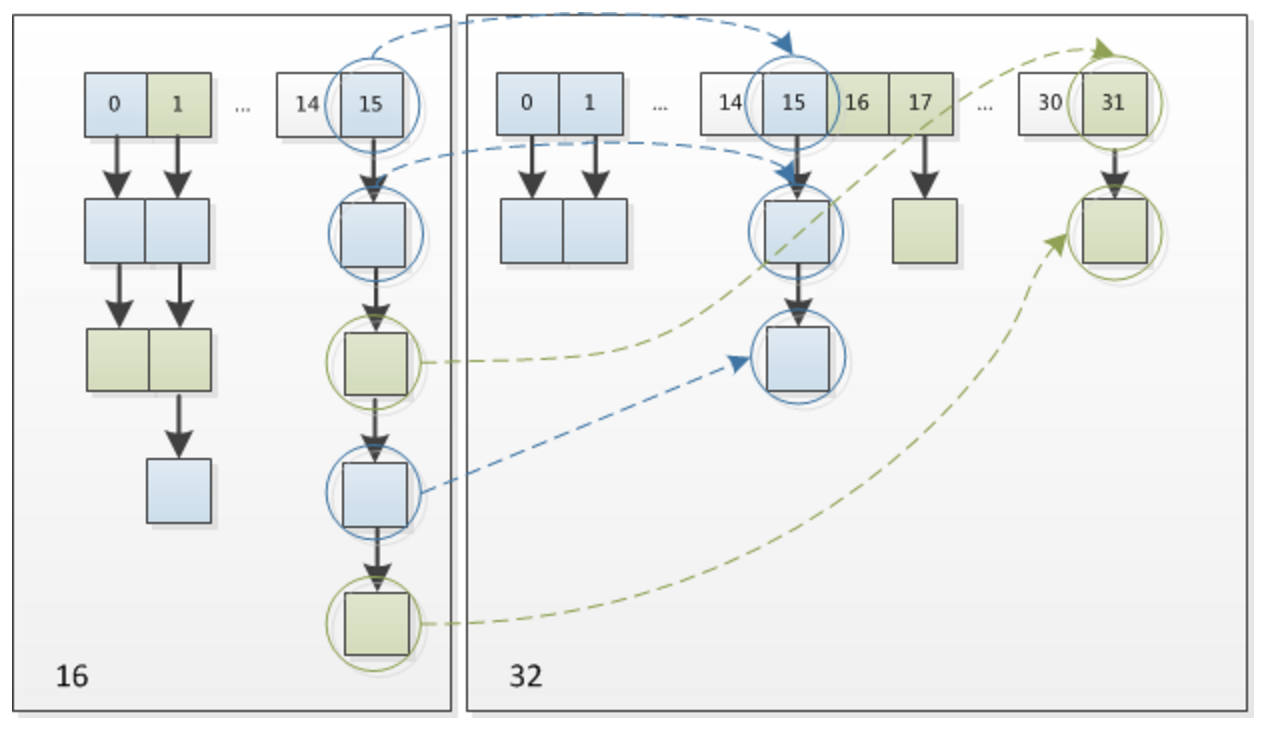
因此,我们在扩充HashMap的时候,只需要看看原来的hash值新增的那个bit是1还是0就好了,是0的话索引没变,是1的话索引变成“原索引+oldCap”,由于新增的1bit是0还是1可以认为是随机的,因此resize的过程,均匀的把之前的冲突的节点分散到新的哈希桶。
1 2 3 4 5 6 7 8 9 10 11 12 13 14 15 16 17 18 19 20 21 22 23 24 25 26 27 28 29 30 31 32 33 34 35 36 37 38 39 40 41 42 43 44 45 46 47 48 49 50 51 52 53 54 55 56 57 58 59 60 61 62 63 64 65 66 67 68 69 70 71 72 73 74 75 76 77 78 79 80 81 82 83 84 85 86 87 88 89 90 final Node<K,V>[] resize() { Node<K,V>[] oldTab = table; int oldCap = (oldTab == null ) ? 0 : oldTab.length; int oldThr = threshold; int newCap, newThr = 0 ; if (oldCap > 0 ) { if (oldCap >= MAXIMUM_CAPACITY) { threshold = Integer.MAX_VALUE; return oldTab; } else if ((newCap = oldCap << 1 ) < MAXIMUM_CAPACITY && oldCap >= DEFAULT_INITIAL_CAPACITY) newThr = oldThr << 1 ; } else if (oldThr > 0 ) newCap = oldThr; else { newCap = DEFAULT_INITIAL_CAPACITY; newThr = (int )(DEFAULT_LOAD_FACTOR * DEFAULT_INITIAL_CAPACITY); } if (newThr == 0 ) { float ft = (float )newCap * loadFactor; newThr = (newCap < MAXIMUM_CAPACITY && ft < (float )MAXIMUM_CAPACITY ? (int )ft : Integer.MAX_VALUE); } threshold = newThr; @SuppressWarnings({"rawtypes","unchecked"}) Node<K,V>[] newTab = (Node<K,V>[])new Node[newCap]; table = newTab; if (oldTab != null ) { for (int j = 0 ; j < oldCap; ++j) { Node<K,V> e; if ((e = oldTab[j]) != null ) { oldTab[j] = null ; if (e.next == null ) newTab[e.hash & (newCap - 1 )] = e; else if (e instanceof TreeNode) ((TreeNode<K,V>)e).split(this , newTab, j, oldCap); else { Node<K,V> loHead = null , loTail = null ; Node<K,V> hiHead = null , hiTail = null ; Node<K,V> next; do { next = e.next; if ((e.hash & oldCap) == 0 ) { if (loTail == null ) loHead = e; else loTail.next = e; loTail = e; } else { if (hiTail == null ) hiHead = e; else hiTail.next = e; hiTail = e; } } while ((e = next) != null ); if (loTail != null ) { loTail.next = null ; newTab[j] = loHead; } if (hiTail != null ) { hiTail.next = null ; newTab[j + oldCap] = hiHead; } } } } } return newTab; }
putVal方法,向hash表里插入值。如果参数onlyIfAbsent是true,那么不会覆盖相同key的值value,evict用于LinkedHashMap,下面是putVal方法的执行流程图。
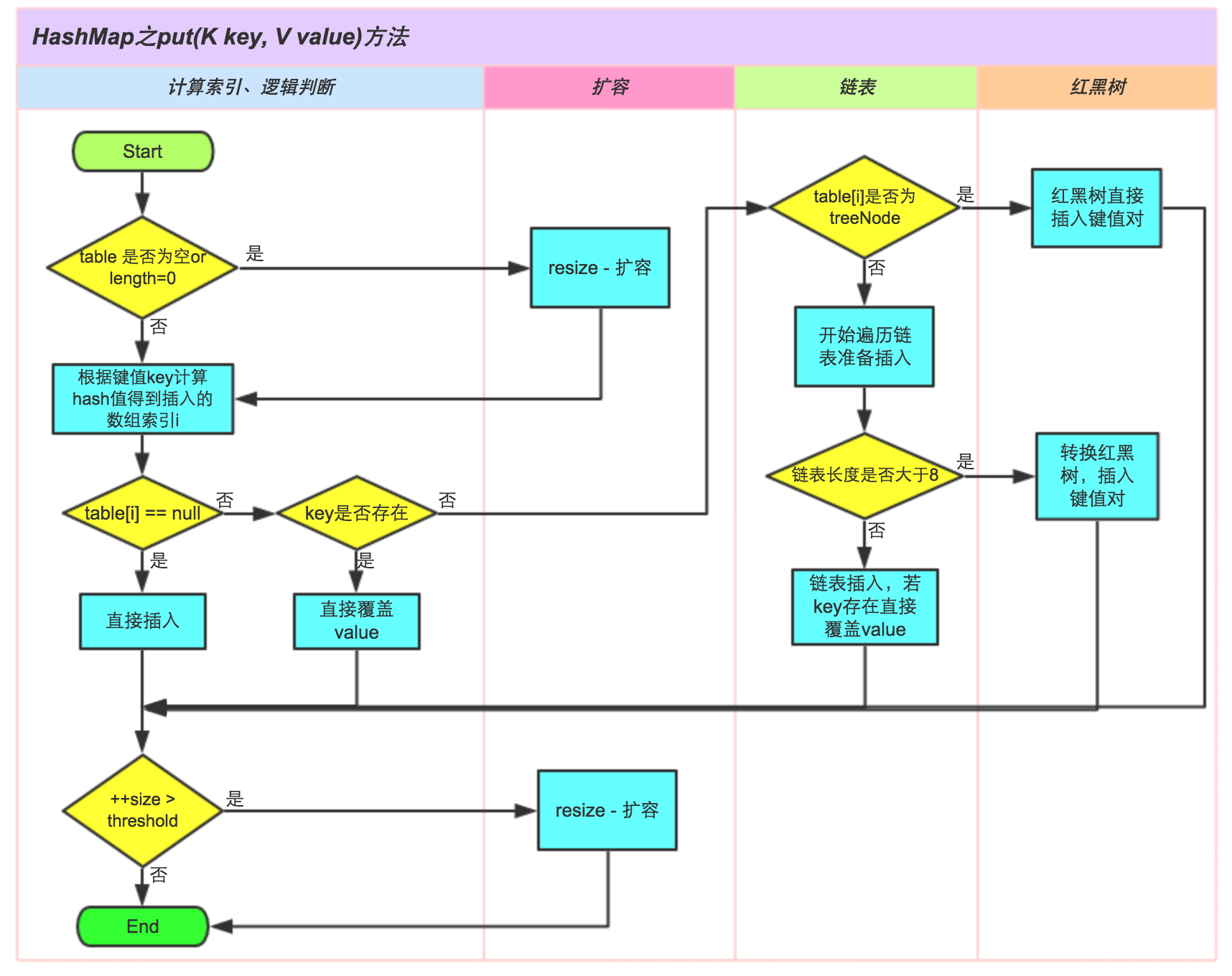
可以结合上面的图看一下对应的源码。
1 2 3 4 5 6 7 8 9 10 11 12 13 14 15 16 17 18 19 20 21 22 23 24 25 26 27 28 29 30 31 32 33 34 35 36 37 38 39 40 41 42 43 44 45 46 47 48 49 50 51 52 53 54 55 56 57 58 59 60 61 62 63 64 65 66 67 68 69 70 71 72 73 74 75 76 77 78 79 80 81 82 83 84 85 86 public V put (K key, V value) return putVal(hash(key), key, value, false , true ); } final V putVal (int hash, K key, V value, boolean onlyIfAbsent, boolean evict) Node<K,V>[] tab; Node<K,V> p; int n, i; if ((tab = table) == null || (n = tab.length) == 0 ) n = (tab = resize()).length; if ((p = tab[i = (n - 1 ) & hash]) == null ) tab[i] = newNode(hash, key, value, null ); else { Node<K,V> e; K k; if (p.hash == hash && ((k = p.key) == key || (key != null && key.equals(k)))) e = p; else if (p instanceof TreeNode) e = ((TreeNode<K,V>)p).putTreeVal(this , tab, hash, key, value); else { for (int binCount = 0 ; ; ++binCount) { if ((e = p.next) == null ) { p.next = newNode(hash, key, value, null ); if (binCount >= TREEIFY_THRESHOLD - 1 ) treeifyBin(tab, hash); break ; } if (e.hash == hash && ((k = e.key) == key || (key != null && key.equals(k)))) break ; p = e; } } if (e != null ) { V oldValue = e.value; if (!onlyIfAbsent || oldValue == null ) e.value = value; afterNodeAccess(e); return oldValue; } } ++modCount; if (++size > threshold) resize(); afterNodeInsertion(evict); return null ; } Node<K,V> newNode (int hash, K key, V value, Node<K,V> next) { return new Node<>(hash, key, value, next); } final void treeifyBin (Node<K,V>[] tab, int hash) int n, index; Node<K,V> e; if (tab == null || (n = tab.length) < MIN_TREEIFY_CAPACITY) resize(); else if ((e = tab[index = (n - 1 ) & hash]) != null ) { TreeNode<K,V> hd = null , tl = null ; do { TreeNode<K,V> p = replacementTreeNode(e, null ); if (tl == null ) hd = p; else { p.prev = tl; tl.next = p; } tl = p; } while ((e = e.next) != null ); if ((tab[index] = hd) != null ) hd.treeify(tab); } } TreeNode<K,V> replacementTreeNode (Node<K,V> p, Node<K,V> next) { return new TreeNode<>(p.hash, p.key, p.value, next); }
getNode方法。根据key的hash值和key来获取元素(对象)。在HashMap中通过hash值可以快速定位到元素所在的位置,然后根据key(key是唯一的)来找出元素所在的链表位置(或者树的位置)。所以从某个角度讲HashMap也是一个空间换时间的一种数据结构。他通过存储key和key的Hash值来快速定位元素。
1 2 3 4 5 6 7 8 9 10 11 12 13 14 15 16 17 18 19 20 21 22 23 24 25 26 27 28 29 30 31 public V get (Object key) Node<K,V> e; return (e = getNode(hash(key), key)) == null ? null : e.value; } final Node<K,V> getNode (int hash, Object key) Node<K,V>[] tab; Node<K,V> first, e; int n; K k; if ((tab = table) != null && (n = tab.length) > 0 && (first = tab[(n - 1 ) & hash]) != null ) { if (first.hash == hash && ((k = first.key) == key || (key != null && key.equals(k)))) return first; if ((e = first.next) != null ) { if (first instanceof TreeNode) return ((TreeNode<K,V>)first).getTreeNode(hash, key); do { if (e.hash == hash && ((k = e.key) == key || (key != null && key.equals(k)))) return e; } while ((e = e.next) != null ); } } return null ; }
removeNode,删除哈希桶里面的值。同时要判断是否要使用值匹配。但是默认的都是不匹配的,如果使用匹配找到key和value相同的才会删除,否则返回null;
1 2 3 4 5 6 7 8 9 10 11 12 13 14 15 16 17 18 19 20 21 22 23 24 25 26 27 28 29 30 31 32 33 34 35 36 37 38 39 40 41 42 43 44 45 46 47 48 49 50 51 52 53 54 55 56 57 58 59 60 61 public V remove (Object key) Node<K,V> e; return (e = removeNode(hash(key), key, null , false , true )) == null ? null : e.value; } final Node<K,V> removeNode (int hash, Object key, Object value, boolean matchValue, boolean movable) Node<K,V>[] tab; Node<K,V> p; int n, index; if ((tab = table) != null && (n = tab.length) > 0 && (p = tab[index = (n - 1 ) & hash]) != null ) { Node<K,V> node = null , e; K k; V v; if (p.hash == hash && ((k = p.key) == key || (key != null && key.equals(k)))) node = p; else if ((e = p.next) != null ) { if (p instanceof TreeNode) node = ((TreeNode<K,V>)p).getTreeNode(hash, key); else { do { if (e.hash == hash && ((k = e.key) == key || (key != null && key.equals(k)))) { node = e; break ; } p = e; } while ((e = e.next) != null ); } } if (node != null && (!matchValue || (v = node.value) == value || (value != null && value.equals(v)))) { if (node instanceof TreeNode) ((TreeNode<K,V>)node).removeTreeNode(this , tab, movable); else if (node == p) tab[index] = node.next; else p.next = node.next; ++modCount; --size; afterNodeRemoval(node); return node; } } return null ; } public void clear () Node<K,V>[] tab; modCount++; if ((tab = table) != null && size > 0 ) { size = 0 ; for (int i = 0 ; i < tab.length; ++i) tab[i] = null ; } }
HashMap中线程安全问题 1 2 3 4 5 6 7 8 9 10 11 12 13 14 15 16 17 18 19 20 21 22 23 24 25 26 27 28 29 30 31 32 33 34 35 36 37 38 39 40 41 42 43 44 45 46 47 48 49 50 51 52 53 54 abstract class HashIterator Node<K,V> next; Node<K,V> current; int expectedModCount; int index; HashIterator() { expectedModCount = modCount; Node<K,V>[] t = table; current = next = null ; index = 0 ; if (t != null && size > 0 ) { do {} while (index < t.length && (next = t[index++]) == null ); } } public final boolean hasNext () return next != null ; } final Node<K,V> nextNode () Node<K,V>[] t; Node<K,V> e = next; if (modCount != expectedModCount) throw new ConcurrentModificationException(); if (e == null ) throw new NoSuchElementException(); if ((next = (current = e).next) == null && (t = table) != null ) { do {} while (index < t.length && (next = t[index++]) == null ); } return e; } public final void remove () Node<K,V> p = current; if (p == null ) throw new IllegalStateException(); if (modCount != expectedModCount) throw new ConcurrentModificationException(); current = null ; K key = p.key; removeNode(hash(key), key, null , false , false ); expectedModCount = modCount; } }
在多线程使用场景中,应该尽量避免使用线程不安全的HashMap,而使用线程安全的ConcurrentHashMap。那么为什么说HashMap是线程不安全的,因为在数据增加的时候会导致resize(扩容),会导致链表上数据发生变化,容易在多线程情况下是很容易造成链表回路。在get的情况下造成死循环。
1 2 3 4 5 6 7 8 9 10 11 12 13 14 15 16 17 18 19 20 public class HashMapInfiniteLoop private static HashMap<Integer,String> map = new HashMap<Integer,String>(2 ,0.75f ); public static void main (String[] args) map.put(5 , "C" ); new Thread("Thread1" ) { public void run () map.put(7 , "B" ); System.out.println(map); }; }.start(); new Thread("Thread2" ) { public void run () map.put(3 , "A); System.out.println(map); }; }.start();
map初始化为一个长度为2的数组,loadFactor=0.75,threshold=2*0.75=1,也就是说当put第二个key的时候,map就需要进行resize。通过设置断点让线程1和线程2同时debug到transfer方法的首行。注意此时两个线程已经成功添加数据。放开thread1的断点至transfer方法的“Entry next = e.next;” 这一行;然后放开线程2的的断点,让线程2进行resize。结果如下图
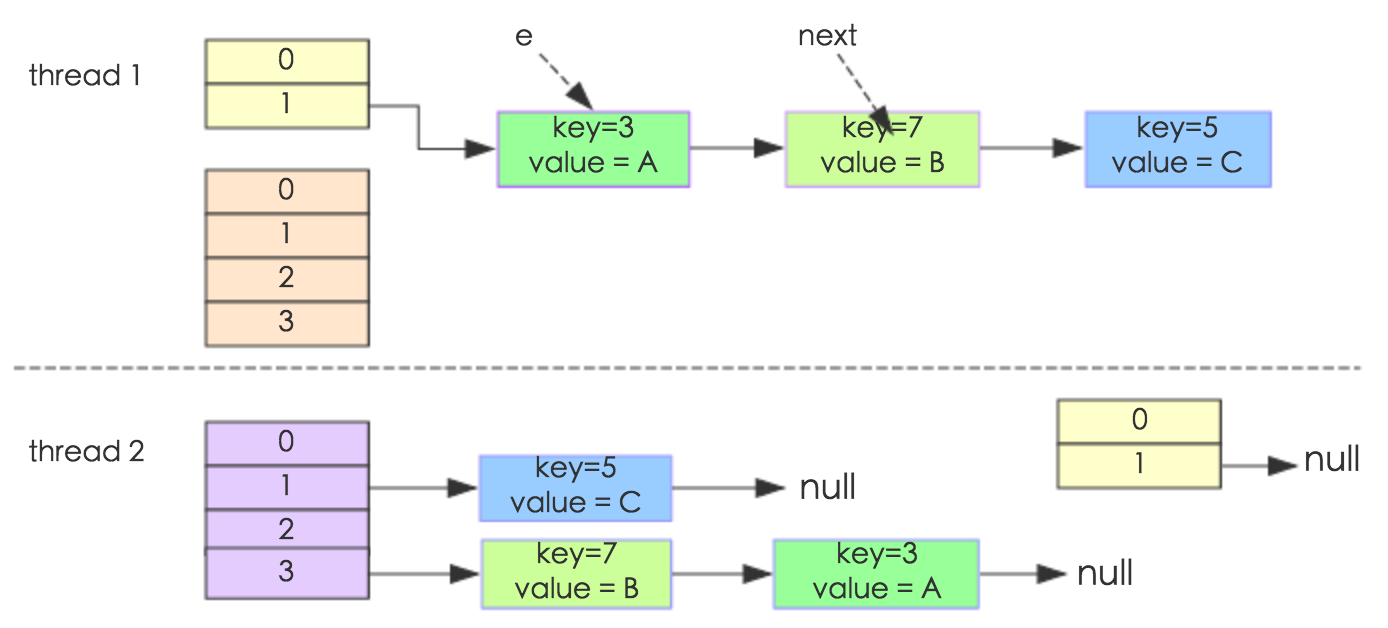
注意,Thread1的 e 指向了key(3),而next指向了key(7),其在线程二rehash后,指向了线程二重组后的链表。线程一被调度回来执行,先是执行 newTalbe[i] = e, 然后是e = next,导致了e指向了key(7),而下一次循环的next = e.next导致了next指向了key(3)。
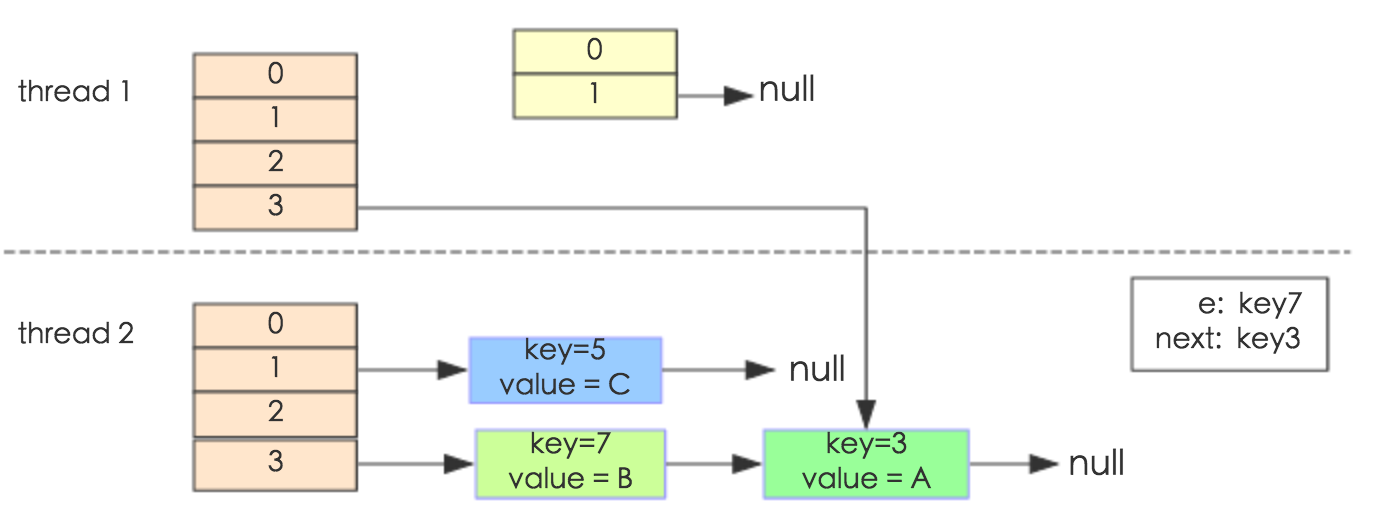
e.next = newTable[i] 导致 key(3).next 指向了 key(7)。注意:此时的key(7).next 已经指向了key(3), 环形链表就这样出现了
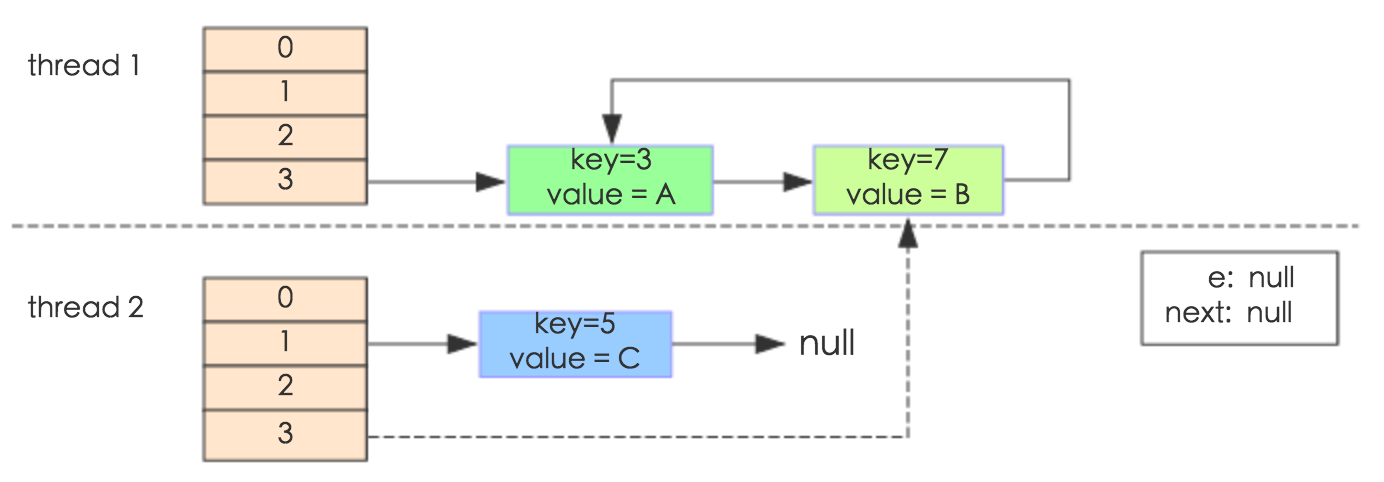
于是,当我们用线程一调用map.get(11)时,悲剧就出现了——Infinite Loop(无限循环)。
HashMap与HashTable 的区别 HashTable是线程安全的,且不允许key、value是null。HashTable默认容量是11。
HashTable是直接使用key的hashCode(key.hashCode())作为hash值,不像HashMap内部使用static final int hash(Object key)获取hash值。
HashTable取哈希桶下标是直接用模运算%.(因为其默认容量也不是2的n次方。所以也无法用位运算替代模运算)
扩容时,新容量是原来的2倍+1。int newCapacity = (oldCapacity << 1) + 1;
Hashtable是Dictionary的子类同时也实现了Map接口,HashMap是Map接口的一个实现类;
参考 HashMap源码解析(JDK8)
Java 8系列之重新认识HashMap
